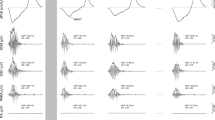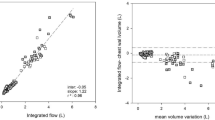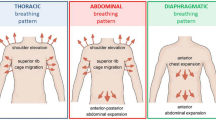Abstract
OBJECTIVE:
The aim of this study was to investigate the effect of excessive mechanical load caused by obesity on the inspiratory muscle performance in obese men at rest.
METHODS:
We therefore measure at rest spirometric flows and the noninvasive tension time index of inspiratory muscle (TTmus=PI/PImax × TI/TTOT) in eight obese male subjects (body mass index (BMI)>30) and 10 controls.
RESULTS:
Spirometric flow (FEV1% pred, FVC% pred) and maximal inspiratory pressure (PImax) were significantly lower in obese subjects compared to controls (P<0.001). The mean TTmus was significantly higher in obese subjects than in controls (0.136±0.003 vs 0.045±0.01). The increase in TTmus was primarily due to an increase in the ratio of mean inspiratory pressure to maximal inspiratory pressure (PI/PImax) and the duty cycle (TI/TTOT). We found a significant negative relationship between PImax and BMI (r=−0.74, P<0.001), a positive correlation between TTmus and BMI (r=0.80, P<0.001) and a negative correlation between TTmus and forced expiratory volume in 1 s (r=−0.85, P< 0.001).
CONCLUSION:
Excessive mechanical load caused by obesity imposes a great burden on the inspiratory muscle, which may predispose such subjects to respiratory muscle weakness at rest.
This is a preview of subscription content, access via your institution
Access options
Subscribe to this journal
Receive 12 print issues and online access
$259.00 per year
only $21.58 per issue
Buy this article
- Purchase on Springer Link
- Instant access to full article PDF
Prices may be subject to local taxes which are calculated during checkout

Similar content being viewed by others
References
Babb TG . Mechanical ventilatory constraints in aging, lung disease, and obesity: perspectives and brief review. Med Sci Sports Exerc 1999; 31: S12–S22.
Refsum HE, Holter PH, Lovig T, Haffner JF, Stadaas JO . Pulmonary function and energy expenditure after marked weight loss in obese women: observations before and one year after gastric banding. Int J Obes Relat Metab Disord 1990; 14: 175–183.
Pankow W, Podszus T, Gutheil T, Penzel T, Peter J, Von Wichert P . Expiratory flow limitation and intrinsic positive end-expiratory pressure in obesity. J Appl Physiol 1998; 85: 1236–1243.
Ray CS, Sue DY, Bray G, Hansen JE, Wasserman K . Effects of obesity on respiratory function. Am Rev Respir Dis 1983; 128: 501–506.
Carey IM, Cook DG, Strachan DP . The effects of adiposity and weight change on forced expiratory volume decline in a longitudinal study of adults. Int J Obes Relat Metab Disord 1999; 23: 979–985.
Gibson GJ . Obesity, respiratory function and breathlessness. Thorax 2000; 55 (Suppl 1): S41–S44.
Sampson MG, Grassino K . Neuromechanical properties in obese patients during carbon dioxide rebreathing. Am J Med 1983; 75: 81–90.
Kress JP, Pohlman AS, Alverdy J, Hall JB . The impact of morbid obesity on oxygen cost of breathing (VO(2RESP)) at rest. Am J Respir Crit Care Med 1999; 160: 883–886.
Yap JC, Watson RA, Gilbey S, Pride NB . Effects of posture on respiratory mechanics in obesity. J Appl Physiol 1995; 79: 1199–1205.
Farkas GA, Schlenker EH . Pulmonary ventilation and mechanics in morbidly obese Zucker rats. Am J Respir Crit Care Med 1994; 150: 356–362.
Bellemare F, Grassino A . Effect of pressure and timing of contraction on human diaphragm fatigue. J Appl Physiol 1982; 53: 1190–1195.
Bellemare F, Grassino A . Force reserve of the diaphragm in patients with chronic obstructive pulmonary disease. J Appl Physiol 1983; 55: 8–15.
Ramonatxo M, Boulard P, Prefaut C . Validation of a noninvasive tension–time index of inspiratory muscles. J Appl Physiol 1995; 78: 646–653.
Standardization of Spirometry 1994 Update. American Thoracic Society. Am J Respir Crit Care Med 1995; 152: 1107–1136.
Roca J, Burgos F, Sunyer J, Saez M, Chinn S, Anto JM, Rodriguez-Roisin R, Quanjer PH, Nowak D, Burney P . References values for forced spirometry. Group of the European Community Respiratory Health Survey. Eur Respir J 1998; 11: 1354–1362.
Black LF, Hyatt RE . Maximal respiratory pressures: normal values and relationship to age and sex. Am Rev Respir Dis 1969; 99: 696–702.
Gaultier C, Boule M, Tournier G, Girard F . Inspiratory force reserve of the respiratory muscles in children with chronic obstructive pulmonary disease. Am Rev Respir Dis 1985; 131: 811–815.
Nava S, Rubini F, Zanotti E, Caldiroli D . The tension–time index of the diaphragm revisited in quadriplegic patients with diaphragm pacing. Am J Respir Crit Care Med 1996; 153: 1322–1327.
Mancini DM, Henson D, LaManca J, Levine S . Respiratory muscle function and dyspnea in patients with chronic congestive heart failure. Circulation 1992; 86: 909–918.
Sharp JT, Henry JP, Sweany SK, Meadows WR, Pietras RJ . The total work of breathing in normal and obese men. J Clin Invest 1964; 43: 728–739.
Laghi F, Tobin MJ . Disorders of the respiratory muscles. Am J Respir Crit Care Med 2003; 168: 10–48.
Enright PL, Adams AB, Boyle PJ, Sherrill DL . Spirometry and maximal respiratory pressure references from healthy Minnesota 65- to 85-year-old women and men. Chest 1995; 108: 663–669.
Enright PL, Kronmal RA, Manolio TA, Schenker MB, Hyatt RE . Respiratory muscle strength in the elderly. Correlates and reference values. Cardiovascular Health Study Research Group. Am J Respir Crit Care Med 1994; 149: 430–438.
Weiner P, Waizman J, Weiner M, Rabner M, Magadle R, Zamir D . Influence of excessive weight loss after gastroplasty for morbid obesity on respiratory muscle performance. Thorax 1998; 53: 39–42.
Luce JM . Respiratory complications of obesity. Chest 1980; 78: 626–631.
Berry JK, Vitalo CA, Larson JL, Patel M, Kim MJ . Respiratory muscle strength in older adults. Nurs Res 1996; 45: 154–159.
Farkas GA, Gosselin LE, Zhan WZ, Schlenker EH, Sieck GC . Histochemical and mechanical properties of diaphragm muscle in morbidly obese Zucker rats. J Appl Physiol 1994; 77: 2250–2259.
Sahebjami H . Dyspnea in obese healthy men. Chest 1998; 114: 1373–1377.
Huang CH, Martin AD, Davenport PW . Effect of inspiratory muscle strength training on inspiratory motor drive and RREP early peak components. J Appl Physiol 2003; 94: 462–468.
Whitelaw WA, Derenne JP . Airway occlusion pressure. J Appl Physiol 1993; 74: 1475–1483.
Whitelaw WA, Derenne JP, Milic-Emili J . Occlusion pressure as a measure of respiratory center output in conscious man. Respir Physiol 1975; 23: 181–199.
Ladosky W, Botelho MA, Albuquerque Jr JP . Chest mechanics in morbidly obese non-hypoventilated patients. Respir Med 2001; 95: 281–286.
Rochester DF . Respiratory muscles and ventilatory failure: 1993 perspective. Am J Med Sci 1993; 305: 394–402.
Smith-Blair N . Mechanisms of diaphragm fatigue. AACN Clin Issues 2002; 13: 307–319.
Acknowledgements
We thank the medical staff of the Department of Cardiac Rehabilitation of Corbie's Hospital for their technical assistance and the obese subjects from the Nutritional and Physical Rehabilitation Department of Corbie's Hospital for their dedication to the study.
Author information
Authors and Affiliations
Corresponding author
Rights and permissions
About this article
Cite this article
Chlif, M., Keochkerian, D., Mourlhon, C. et al. Noninvasive assessment of the tension–time index of inspiratory muscles at rest in obese male subjects. Int J Obes 29, 1478–1483 (2005). https://doi.org/10.1038/sj.ijo.0803030
Received:
Revised:
Accepted:
Published:
Issue Date:
DOI: https://doi.org/10.1038/sj.ijo.0803030
Keywords
This article is cited by
-
Air pollution inhalation during acute exercise is dependent of the body mass index and ventilation of young men
Environmental Science and Pollution Research (2020)
-
Obesity Surgery and Anesthesiology Risks: a Review of Key Concepts and Related Physiology
Obesity Surgery (2019)
-
Obesity Hypoventilation Syndrome
Current Sleep Medicine Reports (2015)
-
Body mass index and waist circumference are independent risk factors for low vital capacity among Japanese participants of a health checkup: a single-institution cross-sectional study
Environmental Health and Preventive Medicine (2015)
-
Interaction of Metabolic Syndrome with Asthma in Postmenopausal Women: Role of Adipokines
Inflammation (2013)



